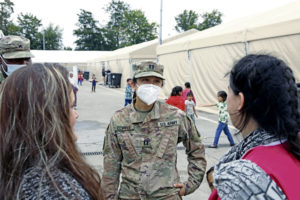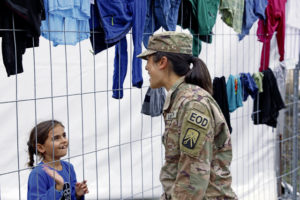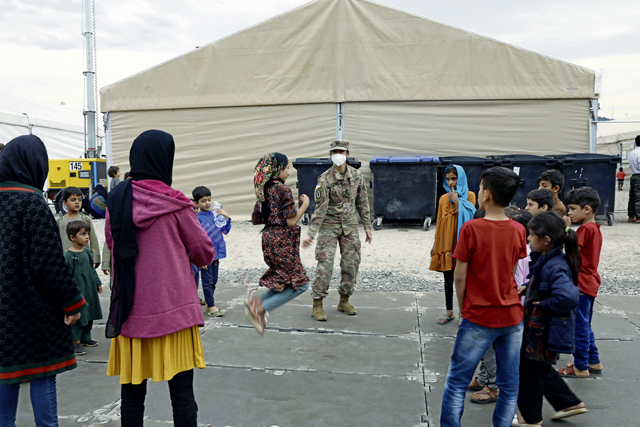
Capt. Emily Copple, 23rd Modular Ordnance Ammunition Company Commander, 18th Combat Sustainment Support Battalion, knows how to navigate delicate situations. As an explosive ordnance disposal officer, she is skilled in neutralizing explosive weapons and creating a safer environment. She does the same thing with people.
For the past three weeks she has commanded the Female Engagement Team organized to support Operation Allies Refuge and Operation Allies Welcome at Ramstein Air Force Base and Rhine Ordnance Barracks in Kaiserslautern. She assumed the post well-prepared, having previously worked alongside female Afghanistan police officers when she was with 49th Ordnance Company.
FET members traditionally go through six months of training to hone language, interpersonal and communication skills, as well as gain experience in key leader engagement. Their mission usually includes intelligence gathering. However, that is not the case during Operation Allies Welcome. The dozens of female Soldiers on the OAW FET in Germany are from the 21st Theater Sustainment Command, specifically, the 18th Combat Sustainment Support Battalion, 16th Sustainment Brigade and 39th Transportation Battalion. They bring a variety of highly valued skills and experiences to the team, but no formal FET training. However, this has not hampered their ability to complete their mission.
“We are not intelligence gathering,” said Copple. “We are trying to bridge that cultural gap, to make the women more comfortable.”
As evacuees, Afghan women travelers are adapting to new surroundings and people, and may also be concerned about loved ones in Afghanistan. Cultural and language differences also create opportunities for misunderstandings or unease.
“For example, if a female falls down and a male Soldier goes to help her up, it could make her uncomfortable,” said Copple. She says the FET ensures there are female Soldiers present as much as possible, and they do regular “presence patrols” in the female areas to ensure no males are where they are not supposed to be.

“Our goal is to just be there for them [the women],” said Copple. The FET has focused on patrols, helping distribute clothing and food, and supporting the women however they can.
“One of my Soldiers held a two to three month old baby while the mother picked out clothes,” said Copple. “I thought it was incredible that she trusted that female Soldier to hold her child.”
Copple shared how little girls gave FET Soldiers henna tattoos to thank them for staying with them throughout the night.
“My Soldiers have done so well,” she said.
She added that the FET is not the only source of female Soldiers on site.
“Everywhere I look, there are female Soldiers stepping up,” said Copple. “There are female medics, a chaplain’s assistant,” she cited as examples.
Copple said supporting OAR and OAW has been a rewarding experience, as she is passionate about helping the Afghanistan people and empowering women. She appreciates the challenges they face.
“What they are fleeing from is really tragic,” she said. “They are leaving with only with what’s on their back. I’m really proud to be a part of history and helping out with this humanitarian crisis with all of my Soldiers.”
She says keeping the peace and maintaining a safe and civil environment is easier when she and the FET have earned both the men and women travelers’ trust.
“When they see me, they know I am there to help them as much as possible,” she said.
An Afghanistan man quoted in the Commander’s Guide to Female Engagement Teams summed up the power of FETs to build trust and maintain peace. “Your men come to fight, but we know the women are here to help.”



